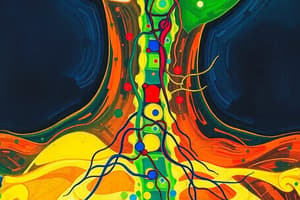Podcast
Questions and Answers
Explain how lumbosacral myelomeningocele affects the spinal column nerves.
Explain how lumbosacral myelomeningocele affects the spinal column nerves.
It disrupts the nerves in the spinal column due to an opening in the backbone through which the spinal cord and meninges protrude.
What is the significance of disrupted spinal column nerves for bladder function in a 3-month-old with myelomeningocele?
What is the significance of disrupted spinal column nerves for bladder function in a 3-month-old with myelomeningocele?
Disrupted nerves can lead to neurogenic bladder dysfunction, affecting the child's ability to control voiding.
How might neurogenic bladder dysfunction manifest in a 3-month-old with lumbosacral myelomeningocele?
How might neurogenic bladder dysfunction manifest in a 3-month-old with lumbosacral myelomeningocele?
It could present as urinary incontinence, urinary retention, or dribbling of urine.
Discuss the implications of neurogenic bladder dysfunction for the long-term management of a 3-month-old with myelomeningocele.
Discuss the implications of neurogenic bladder dysfunction for the long-term management of a 3-month-old with myelomeningocele.
How can parents of a 3-month-old with lumbosacral myelomeningocele support bladder function in their child?
How can parents of a 3-month-old with lumbosacral myelomeningocele support bladder function in their child?
What are the potential storage symptoms associated with detrusor sphincter dyssynergia?
What are the potential storage symptoms associated with detrusor sphincter dyssynergia?
How can detrusor sphincter dyssynergia affect the flow of urine?
How can detrusor sphincter dyssynergia affect the flow of urine?
What are some neurogenic bowel problems commonly experienced by people with spinal cord injuries?
What are some neurogenic bowel problems commonly experienced by people with spinal cord injuries?
How do bladder and bowel problems interact in individuals with spinal cord injuries?
How do bladder and bowel problems interact in individuals with spinal cord injuries?
What are some complications in bladder function that can arise from disrupted spinal column nerves?
What are some complications in bladder function that can arise from disrupted spinal column nerves?
Why is proper diagnosis and treatment essential for individuals with spinal cord injuries experiencing bladder complications?
Why is proper diagnosis and treatment essential for individuals with spinal cord injuries experiencing bladder complications?
What are the symptoms of an underactive bladder in individuals with spinal cord injuries?
What are the symptoms of an underactive bladder in individuals with spinal cord injuries?
Describe the characteristics of a reflex, or spastic, bladder in individuals with spinal cord injuries.
Describe the characteristics of a reflex, or spastic, bladder in individuals with spinal cord injuries.
How can damage to the nerves responsible for bladder control lead to neurogenic bladder dysfunction?
How can damage to the nerves responsible for bladder control lead to neurogenic bladder dysfunction?
Explain the impact of an underactive bladder on the risk of urinary tract infections in those with spinal cord injuries.
Explain the impact of an underactive bladder on the risk of urinary tract infections in those with spinal cord injuries.
What distinguishes a flaccid bladder from a spastic bladder in individuals with spinal cord injuries?
What distinguishes a flaccid bladder from a spastic bladder in individuals with spinal cord injuries?
How does an overactive bladder impact the quality of life of individuals with spinal cord injuries?
How does an overactive bladder impact the quality of life of individuals with spinal cord injuries?
Flashcards are hidden until you start studying




